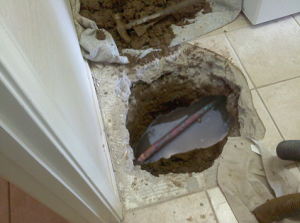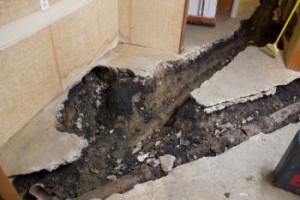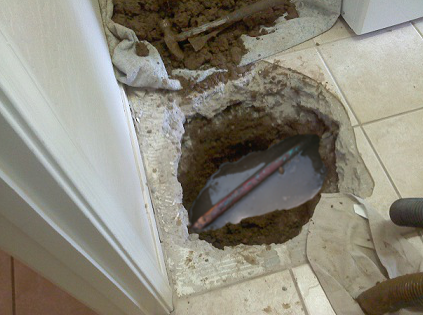
Arizona Homeowners insured with State Farm Insurance need to be aware that State Farm does not pay for plumbing access costs. For many of our clients, that can amount to thousands of dollars of out-of-pocket costs when their plumbing fails by bursting or collapsing, causing damage to their homes. If you’ve had a plumbing failure and you’re wondering why State Farm didn’t pay for your plumbing access costs, this article will help spell it out for you – using the specific policy language that is contained in State Farm’s policy and endorsement forms.
What is Plumbing Access?
Plumbing access is something that is required when a supply line or drain pipe breaks in a place where demolition is required to access it in order to make repairs. Many homeowners here in Arizona may not even realize that their plumbing was installed underneath the concrete foundation (or slab). If a pipe or drain line bursts or collapses underneath there and you’re insured with State Farm, that entire cost will be on you!
Does Any Insurance Company Pay For Plumbing Access Costs?
Yes, most of the major insurance carriers pay the costs for plumbing access when certain criteria are met. Keep in mind that two qualifying factors have to occur for a water loss to be considered for coverage by your insurance company. They are:
- Insurance only pays for losses that are sudden and accidental in nature. Long-term leaks are always excluded. In order for your insurance company to consider covering your claim, the pipe or drain line has to have burst, collapsed, or failed suddenly. Anything that’s been ongoing is considered to be a maintenance issue for the homeowner and will not be considered for insurance coverage (often, even if it wasn’t discovered for a while).
- Insurance will only pay for the costs of your plumbing access if direct physical damage was done to your home as a result of the plumbing failure. The fact that the plumbing failed and needs to be repaired is not reason enough for your insurance to cover the costs of that repair. There has to be damage to your home because the plumbing failed. This can be buckled wood flooring, drywall that has become wet, baseboards that are pulling away, wet and warped cabinetry, etc. Without direct physical damage to your home, insurance will not pay the costs for the plumbing access.
However, if you are insured with State Farm in Arizona, your plumbing access costs will not be paid – even if they are thousands of dollars!
How Does State Farm Get Away With That?
State Farm’s standard homeowner policy is called the FP-7955: Homeowners’ Policy. They sell the same boilerplate policy throughout the country. In the boilerplate policy it reads:
1. We do not insure for any loss to the property described in Coverage A which consists of, or is directly and immediately caused by, one or more of the perils listed in items a. through n. below, regardless of whether the loss occurs suddenly or gradually, involves isolated or widespread damage, arises from natural or external forces, or occurs as a result of any combination of these:
…
f. continuous or repeated seepage or leakage of water or steam from a:
(1) heating, air conditioning or automatic fire protective sprinkler system;
(2) household appliance; or
(3) plumbing system, including from, within or around any shower stall, shower bath, tub installation, or other plumbing fixture, including their walls, ceilings or floors:
which occurs over a period of time. If loss to covered property is caused by water or steam not otherwise excluded, we will cover the cost of tearing out and replacing any part of the building necessary to repair the system or appliance. We do not cover loss to the system or appliance from which the water or steam escaped;
I realize that reading an insurance policy can be confusing; however, this is important stuff to understand if you ever suffer a water loss. Basically, their boilerplate policy says in the last paragraph that as long as the water loss hasn’t been going on over a period of time, that State Farm will “cover the cost of tearing out and replacing any part of the building necessary to repair the system or appliance.” Cool beans, right?
Not so fast! One thing you may not understand is that every state has a Department of Insurance who’s job it is to approve forms (aka policies) for the various insurance companies permitted to sell insurance in their state. If the insurance company wants to amend the boilerplate policy, they have to get it approved by the Department of Insurance and then the insurance company includes an “Amendatory Endorsement” with the policy. In the Arizona Amendatory Endorsement from State Farm (form FE-3243), they have replaced Item 1.f with the following:
f. continuous or repeated seepage or leakage of water or steam from a:
(1) heating, air conditioning or automatic fire protective sprinkler system;
(2) household appliance; or
(3) plumbing system, including from, within or around any shower stall, shower bath, tub installation, or other plumbing fixture, including their walls, ceilings or floors;
If you look closely can you see what they did there? That entire paragraph about paying the costs of tearing out and replacing any part of the building necessary to repair the system or appliance has mysteriously vanished! Voila! That translates into hundreds of thousands of dollars of profit in the pocket of State Farm that they don’t have to pay out in claims in Arizona and, conversely, hundreds of dollars in plumbing bills that insured Arizona homeowners are paying out-of-pocket. The rest of the country is getting their plumbing access paid; however, because the Department of Insurance approved this Amendatory Endorsement, they don’t have to pay for it in Arizona.
What Can I Do?

You can replace your homeowners policy with a company that does cover plumbing access. Most of the major companies will cover it. I went on a reinspection last week on an American Family claim and the adjuster told me that American Family changed their policies at the end of March removing plumbing access from their coverages. So, be aware when you purchase a new policy to ask your agent if this very important feature is covered. Also, every year when you get your renewal, carefully read any attached endorsements – as they can change what your policy covers and you’ll never know unless you thoroughly read your renewal documents.


